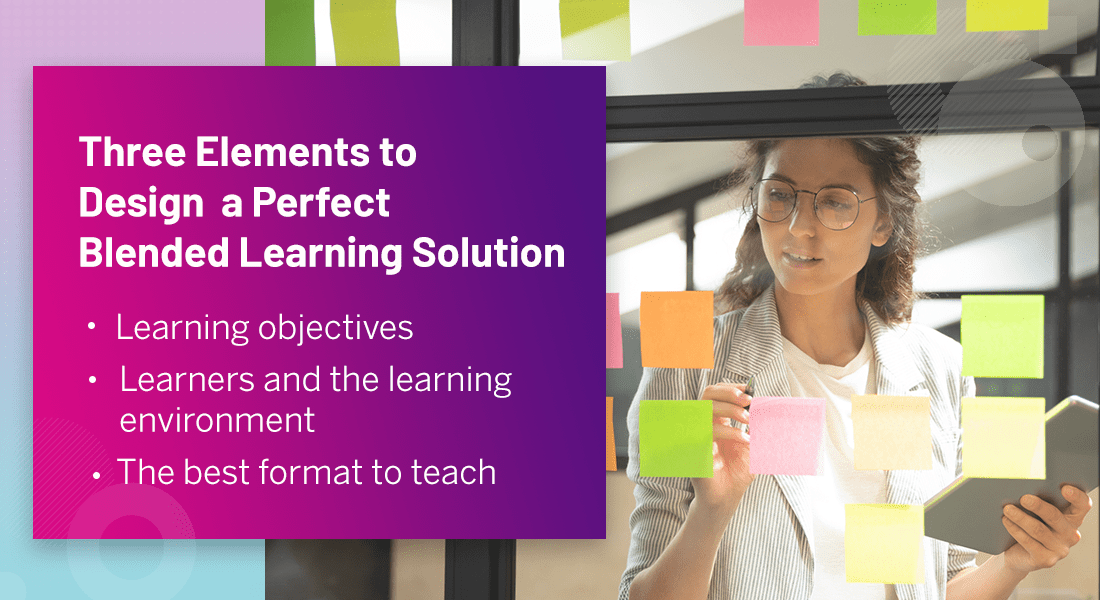Blended Learning for Corporate Training — The 8-Fold Benefits!

Why blended learning? Well, think of it this way – which of these ice creams would you like to have? The plain vanilla or the more interesting one with so many different flavors? That’s a no brainer, right? There was a time when people were perfectly satisfied with plain old vanilla. But today? I don’t think so! Standard (boring?) online or classroom training programs no longer cut the ice with today’s generation of tech savvy and digitally advanced employees.
What they want is different textures, different modes, different formats to keep them engaged and invested in the training. Classroom and online formats have their own pros and cons with regards to costs, time, knowledge transfer, etc., but a combination of the two will go a long way to meet learners’ demands. And that is where blended learning comes in – a learning approach that uses more than one mode to deliver instruction – online training laced with elements of human touch and engaging media.
Contemplating Blended Learning for Your Corporate Training Needs?
Here are 8 ways to say yes to blended learning:
- Provides Flexibility in Learning
- Improves Overall Learning Effectiveness
- Promotes Collaborative Learning
- Supports Just in Time Learning
Read on to explore further…
Jennifer Hofmann, learning expert and author of Blended Learning, What Works in Talent Development, says, “Modern learning audiences want blended learning programs that work the way they do. They need flexible and personalized learning that lets them learn new skills and acquire new knowledge that they can then immediately apply on the job.”
Learning is a process, not an event. And blended learning with its multiple methods and formats, provides greater opportunities for approaching learning as a process and not as an event.
Blended learning makes the best of both worlds, offering numerous advantages for both learners and the organization. Let’s look at some of them now.
Benefits of Blended Learning
1. Provides Flexibility in Learning
Blended learning gives learners control over their learning, offering greater flexibility on how, where, and what they learn. This is especially useful for a globally dispersed workforce or for those in remote locations.
2. Improves Overall Learning Effectiveness
A blended strategy improves learning results by providing a better match between the learner and the learning program as learners have the freedom to choose the format they are most comfortable with.
The combination of various instructional tools, media, and learning resources can have a bigger impact on learners than the traditional classrooms or plain web-based training, leading to better training outcomes.
→ Download Checklist: Is Blended Learning Right For Your Corporate Training?
Blended learning supports collaborative learning in the physical and virtual classroom, and also through online discussion forums. These forums enable learners and instructors to share ideas, opinions, and experiences and help allay any apprehensions learners might have.
4. Supports Just in Time Learning
Learners can access digital asset libraries anytime, anywhere, on any device, as part of ‘just-in-time’ (JIT) learning, which is one among many reasons for the popularity of microlearning in this growing on-demand and ‘pull-learning’ culture.

5. Encourages Continuous Learning
Blended learning provides greater opportunities for continual learning experiences across the learning journey where the learner goes from ignorance to awareness to mastery of the subject, using various formats to achieve excellence in performance.
6. Bids Goodbye to Scheduling Hassles
A major problem with a one-size-fits-all classroom training or a pre-scheduled virtual classroom session is that not everyone may be available to attend training at the same time. Most of these scheduling problems can be resolved with blended learning.
7. Cuts Training Costs and Improves ROI
Blended learning offers huge cost savings on travel and accommodation and also optimizes your resources and time. Development time and costs can also be cut by repurposing digital assets from existing classroom material and online courses.
8. Eases the Transition from Classroom to Online Training
Organizations face many challenges when it comes to implementing eLearning. As with any other change, there will be some resistance, both from the management as well as employees. In such a situation, blended learning is the perfect way to convince all parties concerned for a smooth transition.
Now that we know blended learning can be a feather in your training cap, let’s look at the different training methods and formats you can include in your own blended learning solution.
Options for Blended Learning
Given the huge range of options, how do we ensure the correct mix of different approaches and leverage them for maximum benefit? Well, there is no specific formula, but different formats are appropriate in different contexts to design the perfect blend.
|
Training Methods |
Blended Learning Formats |
| Formal Training |
|
| Self-directed Learning |
|
| Just-in-time Training |
|
| Social Learning |
|
| Performance Support |
|
Wrapping It Up
With organizations having a more global presence today with a geographically diverse workforce, it’s time for training programs to become more dynamic and flexible to get the desired outcomes. Blended learning enables companies to offer different formats at different stages of the learning journey, growing a culture of continuous learning, and offering a more engaging learning experience.
Are you wondering whether blended learning is apt for your corporate training needs? Well, download this checklist to steer clear your confusion.
Editor’s note: This post was originally published in 2010 and has been updated for comprehensiveness.





